A) for each earthquake,the epicenter and hypocenter are located close together
B) neither earthquake is related to the volcano
C) an eruption makes loud noises but not seismic waves
D) landslides cause death but not seismic waves
Correct Answer

verified
Correct Answer
verified
Multiple Choice
In the trench pictured to the right,the information most important to a geologist studying a prehistoric earthquake is: 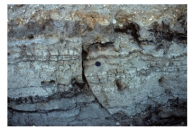
A) there are layers of sediment and soil
B) the sediment is light colored
C) there is a vertical crack in the trench wall
D) the layers have been offset a measurable distance across a crack
Correct Answer

verified
Correct Answer
verified
Multiple Choice
Which of the following is a characteristic of P-waves?
A) They compress and then expand the rock in the direction the wave travels.
B) They are generated near the surface and only compress the rock as they travel.
C) They travel slower than other seismic waves.
D) They displace the rock back and forth in a direction that is perpendicular to their travel direction.
E) They cannot be recorded on seismographs.
Correct Answer

verified
Correct Answer
verified
Multiple Choice
Which of the following is NOT true about some segments of the San Andreas fault?
A) Much of the northern San Andreas fault moved during the 1906 San Francisco earthquake.
B) Some segments of the fault creep slowly rather than storing up large amounts of energy.
C) Some segments of the fault produce moderate-sized earthquakes every couple of decades.
D) The fault has strike-slip motion,so the area west of the fault could fall into the sea.
E) One part of the fault has not moved for more than 100 years.
Correct Answer

verified
Correct Answer
verified
Multiple Choice
The southern San Andreas fault near Los Angeles is considered a candidate for a major earthquake because:
A) it moved fairly recently during the Northridge earthquake and so is ready to move again
B) it is a divergent plate boundary
C) magma is rising along the fault and heating it up
D) this segment of the fault has not moved for more than 100 years
Correct Answer

verified
Correct Answer
verified
Multiple Choice
If an area has shallow,intermediate,and deep earthquakes,what can you infer about the area?
A) it is near a subduction zone
B) the shallow earthquakes will be closer to the trench than deeper ones
C) the depth pattern of earthquakes can be used to determine which way the slab is inclined
D) this area has the potential for large earthquakes
E) all of these
Correct Answer

verified
Correct Answer
verified
Multiple Choice
If an earthquake occurred near the oceanic trench in this figure,which one of the following hazards is likely to threaten the town of Ashton. 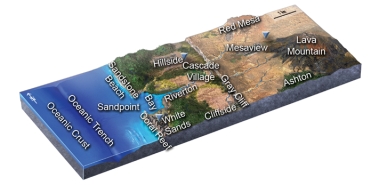
A) destruction by a tsunami
B) liquefaction of soils and other weak materials because of shaking
C) landslides and other slope failures caused by shaking
D) all of these
Correct Answer

verified
Correct Answer
verified
Multiple Choice
The cause of the P-wave shadow zone includes: 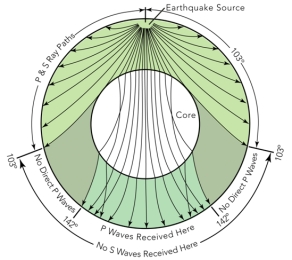
A) P-waves are converted to S-waves,which cannot travel through the core
B) some P-waves are refracted upward before they reach this zone
C) some P-waves are refracted inward into the core,through which they cannot travel
D) the P-waves travel curved paths and are prevented from reaching the core-mantle boundary
E) all of these
Correct Answer

verified
Correct Answer
verified
Multiple Choice
What types of information can be gained from trenches dug across a fault?
A) the offset of layers of sediment and soil
B) samples of charcoal to date by carbon-14
C) layers of carbon-rich peat,which can be dated by carbon-14
D) all of these
Correct Answer

verified
Correct Answer
verified
Multiple Choice
Which of the following can cause extensive damage well after the ground shaking associated with an earthquake stops?
A) tsunami
B) fire
C) flooding from subsidence or failure of dams
D) all of these
Correct Answer

verified
Correct Answer
verified
Multiple Choice
Which of the following features was most likely the cause of the earthquake in the Investigation?
A) oceanic trench
B) collapse of hills along the shoreline
C) faulting along a line of cliffs
D) a landslide off Red Mesa
E) earthquakes from within Lava Mountain
Correct Answer

verified
Correct Answer
verified
Multiple Choice
On this map of southeastern Asia and adjacent areas,which site would have earthquakes along a mid-ocean ridge? 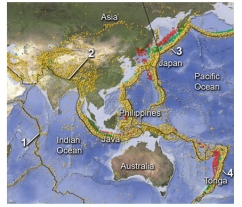
A) 1,in the Indian Ocean
B) 2,in Tibet
C) 3,near Japan
D) 4,near the Tonga island arc
Correct Answer

verified
Correct Answer
verified
Multiple Choice
What likely caused much of the damage shown in this photograph in the 1906 San Francisco earthquake? 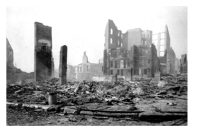
A) a breakdown in the computerized warning system
B) a tsunami
C) fires that broke out after the earthquake
D) ground ruptures,cracks,and fissures
Correct Answer

verified
Correct Answer
verified
Multiple Choice
On this map of southeastern Asia and adjacent areas,which site would have earthquakes along a subduction zone? 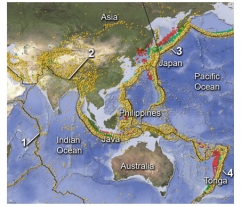
A) 1,in the Indian Ocean
B) 2,in Tibet
C) 3,near Japan
D) 4,near the Tonga island arc
E) 3 and 4
Correct Answer

verified
Correct Answer
verified
Multiple Choice
Which of the following is true about tsunamis?
A) in deep water they are slow enough that a boat can outrun them
B) they form a high wall of water when still in deep water
C) a tsunami can flood areas that are several kilometers inland
D) all of these
E) none of these
Correct Answer

verified
Correct Answer
verified
Multiple Choice
The huge 1964 Alaskan earthquake,one of the largest earthquakes ever recorded,was caused by:
A) rupture on a long segment of a strike-slip fault
B) normal faulting on an ancient fault zone in the crust
C) thrusting along a subduction zone (megathrust)
D) an underwater landslide that caused a tsunami
E) a volcanic eruption on Augustine volcano
Correct Answer

verified
Correct Answer
verified
Multiple Choice
Which feature might indicate that this area has relatively recent earthquakes? 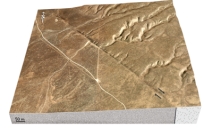
A) a change in topography across the structure
B) the presence of a fault scarp
C) the bends in streams
D) the steam channels on the right side that no longer continue onto the left side
E) all of these
Correct Answer

verified
Correct Answer
verified
Multiple Choice
A seismic wave is refracted to a steeper angle when it: 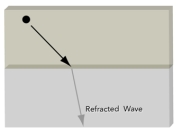
A) passes from a slower material into a faster one
B) passes from a faster material into a slower one
C) keeps going at the same speed but is getting deeper
D) passes from a solid to a liquid
Correct Answer

verified
Correct Answer
verified
Multiple Choice
What was the main cause of death associated with the 2004 Indonesian earthquake?
A) poor construction of buildings
B) ground shaking that caused the soil to turn to a liquid
C) a large ocean wave or tsunami
D) massive fires along the coast
Correct Answer

verified
Correct Answer
verified
Multiple Choice
On this map of South America and adjacent areas,which site would have the deepest earthquakes? 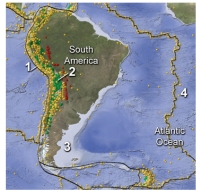
A) 1,the oceanic trench
B) 2,below the magmatic belt
C) 3,along a passive margin
D) 4,in the middle of the Atlantic Ocean
E) both 1 and 2
Correct Answer

verified
Correct Answer
verified
Showing 21 - 40 of 83
Related Exams